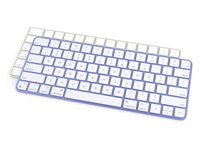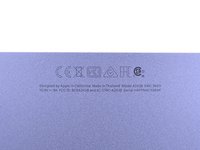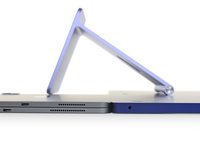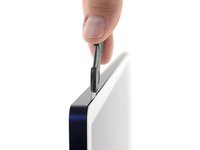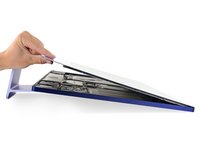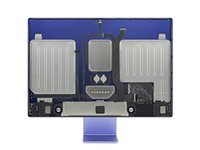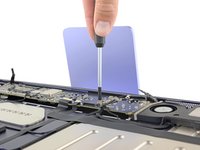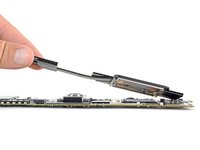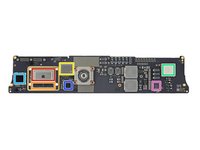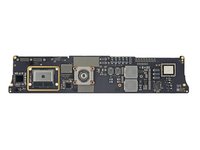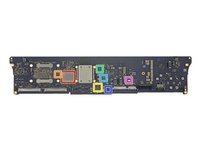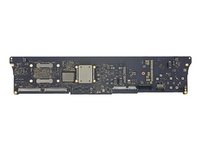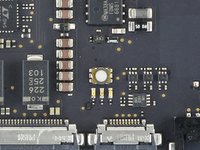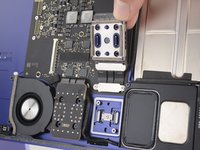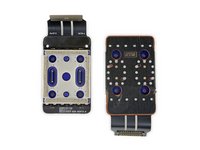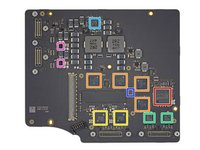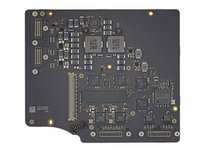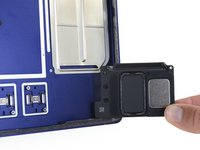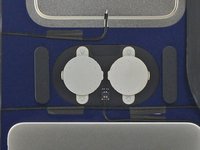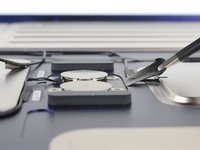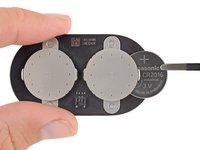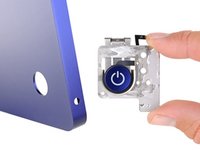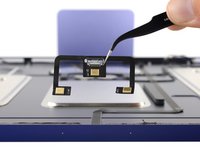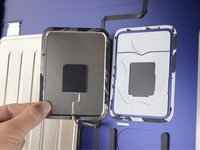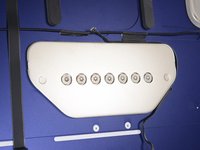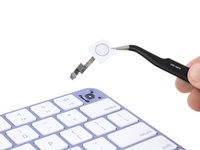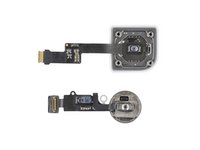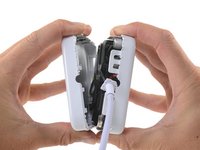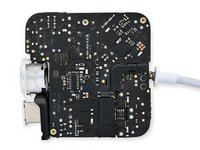Introduction
Is the new M1 iMac just a silly-sized M1 iPad, a detached-keyboard M1 MacBook, an M1 Mac Mini stretched out like pizza dough? We’ll only know by getting inside, however tough that might be. It’s time for a teardown.
For more teardown and repair action, check out our YouTube channel, our Instagram, and our Twitter. Or, to get your iFixit fix right in your digital mailbox, subscribe to our newsletter.
What you need
-
-
You can have this teardown in any color you want, so long as it's purple. We opted for the mid-tier model with the following specs:
-
Apple M1 chip with 8-core CPU (four performance cores and four efficiency cores) and 16-core Neural Engine
-
Apple M1 integrated 8-core GPU
-
8 GB of unified memory
-
23.5-inch (diagonal) True Tone display with 4480 × 2520 resolution and support for one billion colors (P3 color gamut)
-
256 GB of SSD storage
-
-
-
We've been doing iMac teardowns a long time, so we're fairly quick by now—but if you're impatient, nothing beats an X-ray. Check out this beauty from our friends at Creative Electron.
-
Compared to an X-ray of the 27" Intel iMac, we noticed:
-
The new iMac's interior is dominated by two huge metal plates. What are those for?
-
The Apple logo provides a convenient RF pass-thru for some antenna hardware—but unlike in the past, the antenna itself is not Apple-shaped.
-
Almost all of the silicon is concentrated into narrow horizontal strips at the top (the display board) and bottom (main logic board). If you've seen our other M1 Mac teardowns, you might've expected this.
-
PS: Are those two circles in the middle coin cell batteries?
-
-
-
The bundled Magic Keyboard gets its first update since 2017, now featuring round-er corners, iMac-matching color choices, and reorganized function keys.
-
Not to mention, shiny new identifying numbers: model A2449 and EMC 3579.
-
The new Touch ID sensor at the top right looks nothing like MacBook Touch ID—in fact, it's a dead ringer for an iPhone home button. This is Touch ID's first-ever appearance in a peripheral, which has some interesting security/repair implications.
-
-
-
Our midrange unit comes with two Thunderbolt 4 ports and two regular USB-C ports. That's double the base model, but not much for a desktop. Maybe there's room internally for expansion?
-
The circular power port looks like something out of the Matrix. Better take this iMac apart quick, before it learns kung fu.
-
The foot features a new model number: A2438 plus the unique EMC 3663, and touts "Made in Thailand."
-
The M1 iMac is two iPads thin—not deep enough for a headphone jack, so Apple turned its jack sideways to fit.
-
-
Tool used on this step:iMac Opening Wheel$7.99
-
Huzzah! The M1 iMac still uses the classic iMac adhesive—it's not quite the goopy iPad nightmare that we feared.
-
It's not all familiar though. The surprisingly shallow cutting action is disconcertingly bumpy—fortunately, our pizza cutter is just rolling over a series of protective plastic screw posts, nothing delicate.
-
Unlike on past iMacs, it has a single piece of glass—no metal chin to block access to internals. Good slack in the cables and no booby traps!
-
-
Tool used on this step:Marlin Screwdriver Set - 5 Precision Screwdrivers for iPhone$19.99
-
Our 2.5 mm nut driver makes a rare appearance (you may remember its role in the iPhone 6s Teardown)—removing logic board standoff screws. Thanks to our iPhone Marlin kit, we're covered!
-
The fanless M1 MacBook Air-sized logic board is housed in the artificial "chin" of the iMac.
-
Unlike the one in the MacBook Air, this M1 is actively cooled by a pair of fans. Each fan blows inward across the logic board, where the heatsink draws heat away from the M1 with a copper heat pipe and two short heatsinks.
-
We'll circle back later for a closer look at those fans, but we can't resist a bare logic board!
-
-
-
Thanks to the M1 architecture, this is the smallest iMac logic board yet. Let's take a closer look:
-
Apple APL1102/339S00817 64-bit M1 8-core SoC (system on a chip).
-
SK Hynix H9HCNNNCRMMVGR-NEH 8 GB (2 x 4 GB) LPDDR4 memory
-
Kioxia KICM225VE4779 128 GB NAND flash storage
-
Murata 339S00763 Wi-Fi/Bluetooth module
-
Apple APL1096/343S00474 power management IC
-
Apple APL1097/343S00475 power management IC
-
Richtek RT4541GQV power management IC
-
-
-
-
Let's put this thing down, flip it, and reverse it:
-
Kioxia KICM225VE4779 128 GB NAND flash storage
-
Macronix MX25U6472F 64 MB serial NOR flash memory
-
Broadcom BCM57762 ethernet controller
-
Infineon (formerly Cypress Semiconductor) CYPDC1185B2-32LQXQ USB-C cable controller
-
Texas Instruments TPS259827ON 15-amp eFuse with load current monitoring and transient fault management
-
Cirrus Logic CS42L83A audio codec
-
A mysterious button with three LEDs beneath it—what could it be for? Diagnostics? Secret direct-Morse-code line to Tim Cook? Leave your thoughts in the comments!
-
-
-
Let’s talk ports! The USB-C boards flip up like the covers of cigarette lighter sockets in your car. From there, they easily disconnect from the (crazy thin) interconnect board.
-
Even these little guys are color-coordinated. We don't always agree with Apple's choices, but there's no denying their efforts making them.
-
-
-
With this wafer-thin interconnect board out, let's dive in for our second helping of chip ID:
-
ASMedia ASM3142 PCIe-to-USB 3.1 Gen 2 controller
-
Texas Instruments CD3218B12 USB-C port/power delivery controller
-
Intel JHL8040R Thunderbolt 4 retimer
-
ASMedia ASM1543 10 Gbps 4:2 mux switch with USB-C 3.1 compatibility
-
Analog Devices (formerly Linear Technology) LTC3890-2 two-phase synchronous step-down converter
-
Texas Instruments TMP464 five-channel temperature sensor
-
Analog Devices SSM3515B 31-watt class-D audio amplifier
-
-
-
If you—like us, and some keen-eyed tweeters—guessed those shiny metal chambers were part of the new speaker system, you were right!
-
They're impossibly thin (about 1.5 mm at the opening), but their sprawling surface area equates to quite a lot of internal volume, and therefore more air, and fuller sound. Pretty nifty use of what might otherwise be empty space!
-
Speaking of air, our mid-tier iMac comes with two small fans (vs. just one in the base model). This marks the first dual-fan setup in an M1 machine—which ought to be more than enough, considering how well the completely fanless M1 MacBook Air seems to perform with the exact same chip.
-
-
-
Next, let's zoom in on that battery board. The two pins on the output connector show 3V, which suggests these are probably CMOS batteries wired in parallel. But why two of them? And why the strange placement in the middle of the enclosure?
-
Ordinarily, we'd expect to find a single CR2032 battery protecting the NVRAM, like on previous iMacs.
-
Best guess: The new iMac design was too thin for a CR2032 on the main board. That's right—they couldn't squeeze in the battery from an AirTag. So Apple instead used two half-height CR2016s, and squirreled them away over here for clearance.
-
Closer inspection reveals a camouflaged stretch-release adhesive pull tab under the battery board—the same sort of stuff that secures iPhone batteries.
-
Once again, thinness suggests an answer: This is a wafer-thin board, set in place with a vanishingly thin strip of adhesive.
-
-
-
What else can we shake out of this iMacPad? We find:
-
A modular headphone jack. Good news, considering this could be the port that sees the most action. The chassis' thinness does have a silver lining: the headphone jack isn't on the back.
-
A power button, mounted on a sturdy metal bracket, which is glued directly to the enclosure. It actuates on a little hinge.
-
The "studio-quality" triple-microphone array: two up top and one facing forward near the camera.
-
-
-
The Apple logo on the back may not glow like on those classic MacBooks, but it's definitely still radiating. Like past iMacs, it has a cutout that acts as a convenient window for a patch antenna.
-
The display shield features two horizontal slots that hang on corresponding tabs in the case—keeping the display securely mounted. History, but no markings, point to LG Display as a likely maker of this panel.
-
The stand’s hinge hardware is no longer accessible from the outside, so choose VESA from the outset or forever hold your peace—or an iMac opening wheel.
-
-
Tool used on this step:Heavy-Duty Suction Cups (Pair)$14.95
-
As promised, let’s dive back into that shiny new keyboard! Despite the update, it remains a tough nut to crack, but the trifecta of heavy-duty suction, isopropyl alcohol, and patience pays off.
-
The Touch ID key may look like an ordinary keycap on top, but the undercarriage looks very similar to an iPhone 7 Touch ID sensor.
-
That's not a total surprise: Touch ID sensors have been cryptographically paired to their original hardware for years. But these Touch ID peripherals are new, so we kept testing:
-
Two iMacs, one keyboard: once a keyboard is paired to an iMac, it must be unpaired in order to be paired to another iMac. Unpairing a keyboard invalidates the Touch ID profile stored on the iMac, even if it's re-paired to the same keyboard later on.
-
-
-
The new power supply (plus integrated ethernet jack) may live on the outside now, but it won’t escape our tools! We had to bust out the heavy duty stuff but it’s worth it.
-
Repairability benefits: If the iMac's power supply dies, you can easily replace it. Plus, the lack of large exposed capacitors inside the iMac itself (like we've seen in previous generations) means you'll have a safer time poking around in there.
-
On the other hand, no more capacitor swaps—you’re not getting inside this thing without destroying it.
-
The innards look similar to a standard Apple MacBook power supply, albeit with a network cable passing through.
-
The tiny ethernet board is likely strengthening and piping the internets through the black wire bunch.
-
Red wires feed power into the not-Magsafe magnetic umbilical cord.
-
-
-
This concludes our purplest teardown to date—sorry Pixel.
-
Apple's newest iMac follows the other M1 machines down an interesting, but even-less-repairable path.
-
A lot of impressive engineering went into making this thing as thin as possible, but did anyone really need a thinner all-in-one desktop? Apple's priorities continue to baffle.
-
Stay tuned! Up next on the teardown table we've got the new Apple TV and Siri Remote, and maybe even an iPad Pro—so keep checking back.
-
As always, we'll let our repairability scale have the final word.
-
- The fans, USB ports, headphone jack, power button, speakers, and webcam are all reasonably modular and fixable in a pinch.
- The external power supply is trivial to replace, but very difficult to service.
- The display is tedious to remove and replace, but it's the most accessible component.
- There’s no altering the internal storage—a severe blow to repairs, upgrades, data recovery, and even security.
- Memory is soldered directly to the M1 package, making it impractical to ever replace or upgrade.
- The only path of entry is through the display adhesive, making all repairs tedious.
Final Thoughts
Repairability Score


(10 is easiest to repair)
96 Guide Comments
Adhesive…humbug! Give me magnets.
Why? There is nothing upgradeable in the chassis. One can’t upgrade the SSD or RAM so what’s the point of going inside it other than that rare time to maybe clean the dust out of it?
Yeh that's true ..like having a ton of space inside and can’t even have a upgradable m.2 slot thts way too bad. I mean they cold have give a spare slot somewhere.














